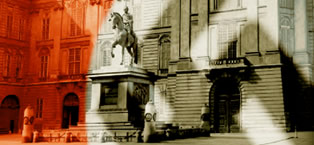 |
Looted Books
The Austrian National Library confronts its Nazi Past
"Looted Books. The Austrian National Library confronts its Nazi Past"
is the theme of an exhibition which is on display in the State Hall of
the Austrian National Library from December 10th to January 23rd. In this
exhibition the library deals with the darkest and most unsavoury chapter
of its history – the aggressive acquisition policy during the Nazi
period, from 1938 to 1945. It was under the library’s director-general
Paul Heigl, who was appointed in March 1938 and who was a fanatic National
Socialist, that the National Library played a very active and dominant
role in the systematic looting of book collections and libraries, many
of them belonging to Austrian Jews and Jewish institutions.
Based on a careful examination of the acquisitions during the Nazi period,
we can say that at least 150,000 printed objects and 45,000 objects from
various collections – which had been seized or stolen from politically
and racially persecuted victims of the Nazi regime – were unlawfully
acquired by the National Library. This figure does not include those looted
objects which did not remain in the National Library but instead were
donated to other libraries or institutions in the German Reich. After
the war the staff of the National Library managed to return part of the
books to their owners. However, other collections, indeed a substantial
part of the looted books and objects, remained in the library stacks as
if they had been acquired legally.
Over the past three years, the Austrian National Library has spent a
great deal of time and effort re-addressing the issue of restitution of
looted property. In December 2003, it presented a 3,000 page Provenance
Report in compliance with a federal law from the year 1998, the so-called
Art Restitution Law, containing a precise list of those books and other
objects which had been acquired unlawfully in the years 1938-1945 and
which are still in the library today. The aim is to return this property
– which involves more than 25,000 objects – to the rightful
owners or their heirs, to the extent they can still be traced. By taking
this step, which comes after more than half a century, the National Library
wants to close this humiliating and shameful chapter in its history.
Through the exhibition “Looted Books” the Austrian National
Library wants to draw attention to a topic which has long been taboo and,
by displaying a representative selection of exhibits, shed light on the
brutal and unscrupulous acquisition policy of those days. Only in a very
few cases do we find precious books, and often the real tragedy behind
the looted objects is the fact they have no real commercial value. This,
in turn, points to the fact that under the Nazi regime the victims were
simply robbed of all their belongings, regardless of their worth.
The exhibition, whose curators are Margot Werner and Christina Köstner,
attempts on the one hand to draw attention to the personal tragedies of
the victims behind the book looting and the wrong which was done to them
by presenting a number of case histories. On the other hand, the display
attempts to provide an overview of the situation in the National Library
during the Nazi regime by highlighting the personal and political involvement
of those staff members who were responsible for the outrageous actions.
The timeframe of the exhibition does not end with the restitution efforts
after the end of WW II. On the contrary, it also deals with current provenance
research.
In addition to showing many hitherto unpublished photographs and records
which still exist in the archive of the Austrian National Library, the
exhibition also displays a selection of confiscated books and collected
objects which have been recommended for restitution. Many of them still
bear traces of their former owners, in some of them we find a book plate
or a handwritten note. Visitors also have the opportunity to look at the
entire Provenance Report.
By staging this exhibition and by returning looted books, the Austrian
National Library is not merely responding to a legal obligation. Moreover,
the library feels it has a truly moral obligation to set things right
and own up to its responsibility. This clear commitment does not stop
here. Research on a comprehensive history of the National Library during
this shameful period is currently underway and the results will published
at the end of 2005.
A catalogue, edited by Murray G. Hall, Christina Köstner and Margot
Werner, will be published to accompany the exhibition. In addition to
providing an historical survey and presenting six case studies about the
individual fate of the victims, it also shows many pictures. The catalogue
also features a subject index, an index of all people mentioned, as well
as a complete list of all the exhibits on display.
|


